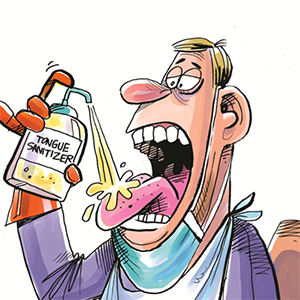Editorial: One man's story exposes the brutal illusion of overly harsh drug sentences
Published in Op Eds
Kaream Akton Moore probably knew that the plastic bag that a stranger paid him $30 to deliver, one August day in 2023, contained drugs. He probably didn’t care. Moore, 42, had been caught in the cruel grip of addiction for nearly three decades at that point; he was homeless and destitute, living behind a Merritt Island apartment complex and getting by on the odd jobs he’d pick up.
A few data points suggest how Moore’s priorities were dictated by the demons of drug addiction.. At the time of his arrest, he weighed 123 pounds. He is nearly 6 feet tall. The only non-drug-related conviction in his long criminal record is a shoplifting charge involving the theft of potato chips.
Kaream Moore is no hero. But he’s nowhere near the kind of monster who conspires to feed the torrent of illegal drugs flooding into Central Florida, spreading misery, breeding other crimes and even taking lives. It might make some people angry to think of him this way, but Moore is more justly counted as a victim of the addiction crisis than a malefactor.
Throughout the vast network of state and federal prisons, there are hundreds, maybe thousands, more like him. And many who have devoted their lives to the justice system have come to see the cruel short-sightedness of laws that ruthlessly assign long sentences to people who are already suffering.
Before he leaves office, President Joe Biden could do something about this savage blindness — as could President-elect Donald Trump when he takes office in late January. We hope they do.
‘Barely a speed bump’
The circumstances of Moore’s case illustrate the case against current sentencing laws so clearly that they attracted one of the area’s leading criminal-defense attorneys to defend him for free, and prompted a scathing, highly unusual cry of anguish from the federal judge who was forced to sentence Moore to five years in federal prison. In a written opinion, U.S. District Judge Roy “Skip” Dalton blasted laws that set harsh minimum sentences tied to the quantity of drugs defendants have in their possession, and the mandates that make such sentences unavoidable unless prosecutors agree to waive them.
“Mr. Moore needs substance abuse treatment, not a long and destructive prison sentence,” Dalton wrote, a few months after he found Moore guilty of conspiracy to distribute and possession with intent to distribute a controlled substance — even though he noted that Moore played no role in deciding what was in the package, who would receive it or what it would be used for. “But Mr. Moore is invisible in our society and our criminal justice system. He’s homeless and won’t be missed. Barely a speed bump on the highway of judicial efficiency. But which pillar of sentencing will be advanced by dispatching Mr. Moore to federal prison for five years at great expense to the taxpayers? Retribution? For a $30 bike ride — hardly. Rehabilitation? Mr. Moore is a longtime drug addict that a stint in prison likely won’t cure. Deterrence? Will another drug addict turn down the certain fix that a $30 delivery will buy because of Mr. Moore’s draconian sentence? Color me skeptical. Incapacitation? Mr. Moore will be off the streets, that’s for sure. But absent intensive substance abuse treatment, that may not be the best of bargains for $30,000 a year of the taxpayer’s money — or the collective conscience.”
In that one paragraph, Dalton effectively exploded the most persuasive arguments used to support minimum-mandatory sentences for low-level offenders, including the reality that behind bars, substance abuse treatment is rare and often low-quality. It’s true that some incarcerated people manage to get sober — and stay that way after their release. But a growing body of research demonstrates that even the most effective prison-based programs carry a high failure rate after a participant is released. That’s no knock on the well-intentioned people who run those programs but it does reflect reality. A highly constrained prison environment is no match for the daily lives of those who leave prison and return to the communities where drugs are easy to get and stability is hard to find. Many slide hopelessly back into lives as nearly invisible wraiths, measured in the intervals between fixes — and arrests.
Lawmakers and other high-ranking officials don’t really seem to care.
The numbers game
So why are minimum mandatory sentences so popular? Because people like Moore don’t seem to matter that much to politicians who want to look tough on crime. In a memorandum to the court prior to Moore’s sentencing, Moore’s attorney Fritz Scheller spelled out many of the ways that legislators have shifted too much control to one side of what is supposed to be an adversial system. Prosecutors can effectively determine an offender’s fate with the charges they file, he wrote.
By adopting inflexible numeric cutoffs — such as the quantity of drugs defendants are caught with, or their prior arrest records — these laws make it easy for politicians to parade their tough-on-crime credentials without having to account for the myriad shades of gray in each case. For example, federal and state laws automatically assume that possession of a specified quantity of drugs establishes an intention to sell them. But those “trafficking” quantities are so low that they can trigger marijuana-trafficking charges for the possession of a single plant.
In the case of the synthetic opioid most commonly known as fentanyl, that weight can include other substances mixed with the actual drug. And the quantity cutoff is incredibly low; with fentanyl, it’s set at 40 grams, about the weight of eight nickels or two AA batteries. While fentanyl can be deadly in very low quantities, the concentration of the drug also makes a big difference.
Unfortunately for Moore, whatever was in the bag he delivered tested positive for fentanyl. Fortunately for society, there was no chance this particular substance would ever threaten the lives of an unwitting drug user — the person Moore delivered it to was a confidential informant working with law enforcement.
In and of itself, that should outrage the conscience: As Scheller points out, this operation wasn’t masterminded by drug kingpins at all. Instead, it was overseen by local law enforcement, and then snapped up by federal prosecutors who knew the case around Moore was airtight, even as they must have realizded he was no conspirator. He was just a tool — first as a means to move the drugs from Point A to Point B, and then as a tally mark on someone’s win-loss record.
“The Government now seeks a penalty of imprisonment that was designed for a kingpin, against an impoverished homeless drug addict. No matter how the Government may dress it up (e.g. a vast conspiracy), the result does not achieve justice,” Scheller wrote.
In this case, however, there are a few rays of hope.
A trend, and a single case
The first could already be breaking. Statistics compiled by the Justice Department show that the rate of minimum mandatory sentences is starting to drop. In 2016, nearly 22% of all federal drug cases involved minimum mandatory sentences. But by the timethose cases reached the sentencing phase, less than 14% of them still included miniumum mandatories. And enthusiasm for minimum mandatory sentences has continued to drop: In 2022, U.S. Attorney General Merrick Garland instructed U.S. district attorneys to avoid minimum sentences in cases where they weren’t merited by other evidence. Pam Bondi, Trump’s pick for Garland’s job, knows the structure of the fentanyl trade better than most attorneys — even prosecutors — in the nation. She should also work to inject more justice and humanity into sentencing.
But there’s a quicker and more compelling way for President Biden to act. He can research the number of federal prison inmates who are serving minimum mandatory sentences that exceed the federal sentencing guidelines, and order those sentences to be commuted. There’s no doubt this issue is on the president’s mind: This month, he issued more than 1,500 pardons of people with low-level drug convictions who had been released from prison during COVID, and his press secretary says more are coming.
For Moore, there’s more reason for hope. Scheller has been talking to the office of U.S. District Attorney Roger Handberg, and says he’s optimistic that a “more equitable” sentence can be negotiated. That should include a shift in charges that removes the dreaded “felony” tag from Moore’s name.
When and if he returns to this community, we hope that Moore takes strength from the realization that his story has made a difference. We hope he finds inspiration from ex-felon role models such as voting-rights activist Desmond Meade and Ruben Saldaña, head of the Credible Messenger program that offers youth alternatives to lives filled with drug abuse and violence — youth who are around the age Moore was when he first started using drugs.
Because hope and humanity are his birthright. Kaream Moore, and others like him, do matter. They have potential — as workers, builders, volunteers, faith leaders. As sons and daughters, as parents, as friends. It’s a crime, and a heartbreaking injustice, when they are reduced to numbers to prop up an illusion that society can incarcerate its way out of the drug crisis. In the end, nobody wins. And, as Scheller sums up in his sentencing memo, “that ain’t right.”
____
The Orlando Sentinel Editorial Board consists of Opinion Editor Krys Fluker, Editor-in-Chief Julie Anderson and Viewpoints Editor Jay Reddick. Contact us at insight@orlandosentinel.com
©2024 Orlando Sentinel. Visit at orlandosentinel.com. Distributed by Tribune Content Agency, LLC.




























































Comments